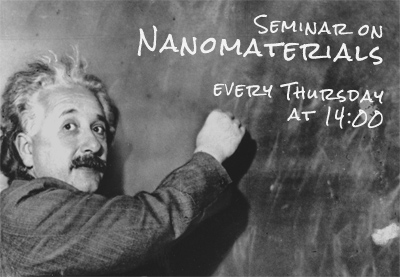Nanoseminar
Group of Structure analysis at the Department of Condensed Matter Physics
of Charles University and MGML has a pleasure to invite you to attend the seminar on nanomaterials: Physics, Technology, Applications
on 14th November 2024 at 14:00
at Faculty of Mathematics and Physics of Charles University, Ke Karlovu 5, 121 16 Praha 2
Lecture room F2
Štěpán Stehlík
Institute of Physics of the Czech Academy of Sciences, Prague, and New Technologies – Research Centre, University of West Bohemia, Pilsen
Nanodiamonds, tiny gemstones with rich science
Štěpán Stehlík » Nanodiamonds, tiny gemstones with rich science
Institute of Physics of the Czech Academy of Sciences, Prague, and New Technologies – Research Centre, University of West Bohemia, Pilsen
Location: F2
Nanodiamonds (NDs) hold promise for a vast range of various applications related to their surface properties (drug delivery, selective biomolecule binding), volumetric properties (cellular labeling and imaging, quantum sensing), and optoelectronic properties (energy harvesting and storage, photocatalysis). Although researchers employ nanodiamonds in all these applications, due to the great variety of this nanomaterial, the actual nanoparticles used can differ substantially. Sometimes to the extent that they could be defined as a different material.
In this contribution, two most common ND types, detonation NDs (DNDs) and high-pressure high-temperature (HPHT) NDs will be introduced and their specifics highlighted. We will review recent experimental advances in the preparation of sub-5 nm NDs of both detonation and HPHT origin, including the HPHT NDs synthesized from molecular precursors1. The presentation aims to critically compare these two ND types from the Raman spectroscopy point of view as this technique is broadly used to assess not only the ND phase composition (C-sp3 and C-sp2 content) but also the ND size. We show that the Raman spectra of DND and HPHT NDs on the 3-5 nm scale are size-insensitive yet significantly different from each other which limits the application of the current phonon confinement models for the ND size distribution analysis2. Finally, we show how to control the size of the ND and answer the question: How small can nanodiamonds be3?
- E. Ekimov et al., Nanomaterials 2022, 12, 351.
- S. Stehlik et al., J. Phys. Chem. C 2021, 125, 5647-5669.
- S. Stehlik et al., J. Phys. Chem. C 2015, 119, 27708-27720
*corresponding author: e-mail: stehlik@fzu.cz


